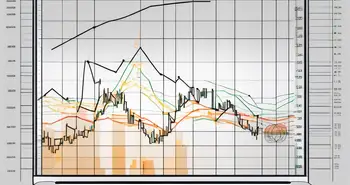The Bitcoin Stock-to-Flow Model: A Comprehensive Overview

As an expert in the field, I am here to provide you with a comprehensive analysis of the Bitcoin Stock to Flow Model, its concept, mathematical framework, predictive power, impact of halving events, and its implications for the future of Bitcoin. Join me as we delve into the fascinating world of Bitcoin and its relationship with scarcity and value.
The Concept of Bitcoin Stock to Flow Model
The Stock to Flow Model is a popular economic model used to analyze Bitcoin's value and predict its future price movements. It measures the abundance or scarcity of an asset by comparing its current stock (existing supply) to its flow (rate of new supply entering the market).
The Origin and Importance of the Stock to Flow Model
The Stock to Flow Model was first introduced by PlanB, a pseudonymous analyst, in a 2019 article. Since then, it has gained significant attention in the cryptocurrency community for its ability to quantify Bitcoin's scarcity and potential price appreciation over time.
Understanding the Stock to Flow Model is crucial for investors and enthusiasts alike, as it provides a unique perspective on Bitcoin's value proposition and future prospects.
The Basic Principles of the Stock to Flow Model
The Stock to Flow Model relies on the principle that scarcity drives value. In other words, the scarcer an asset is, the more valuable it becomes. Bitcoin's limited supply of 21 million coins makes it inherently scarce, which contributes to its desirability and potential for price appreciation.
By analyzing Bitcoin's historical stock and flow data, the Stock to Flow Model calculates the expected price levels that Bitcoin may achieve in the future. This model suggests that as Bitcoin's stock-to-flow ratio increases over time, its value should also increase proportionally.
One interesting aspect of the Stock to Flow Model is its ability to capture the unique characteristics of Bitcoin's supply. Unlike traditional fiat currencies that can be printed at will by central banks, Bitcoin's supply is governed by a predetermined algorithm. This algorithm ensures that new Bitcoins are introduced into the market at a decreasing rate over time, leading to a diminishing flow. This scarcity is a fundamental factor that contributes to Bitcoin's value and sets it apart from other assets.
Moreover, the Stock to Flow Model takes into account the halving events that occur approximately every four years in the Bitcoin network. During these events, the block reward for miners is cut in half, reducing the rate at which new Bitcoins enter circulation. This reduction in supply further enhances Bitcoin's scarcity and has historically led to significant price increases.
It is important to note that the Stock to Flow Model has its critics. Some argue that it oversimplifies the complex dynamics of the cryptocurrency market and fails to consider other fundamental factors that can influence Bitcoin's price. Additionally, the model's predictive power has been a subject of debate, as it relies heavily on historical data and assumes that the relationship between stock-to-flow ratio and price will remain constant in the future.
Nevertheless, the Stock to Flow Model has become a valuable tool for many Bitcoin investors and analysts. It provides a framework for understanding the relationship between scarcity and value in the cryptocurrency market, offering insights into potential price movements and long-term investment strategies.
The Mathematical Framework of the Bitcoin Stock to Flow Model
The Stock to Flow Model utilizes a mathematical framework to estimate Bitcoin's future price levels based on its existing stock and the rate at which new Bitcoins enter the market.
The Role of Scarcity in the Model
Scarcity is a fundamental factor in the Stock to Flow Model. Bitcoin's limited supply and predictable issuance schedule contribute to its scarcity value. As the model predicts, Bitcoin's scarcity will continue to increase over time, potentially driving its price to new heights.
Understanding the Time Series Analysis
Time series analysis is an integral part of the Stock to Flow Model. It involves examining Bitcoin's historical data to identify patterns and trends that can be used to forecast future price movements. By analyzing data such as previous halving events and market cycles, the model provides insights into potential price trajectories.
The Predictive Power of the Bitcoin Stock to Flow Model
The Stock to Flow Model has garnered attention due to its historical accuracy in predicting Bitcoin's value. It has successfully captured Bitcoin's major price movements and highlighted the potential for exponential growth. However, it's essential to acknowledge the limitations and criticisms associated with the model.
The Model's Accuracy in Predicting Bitcoin's Value
The Stock to Flow Model has shown a remarkable ability to predict Bitcoin's value over extended periods. Its accuracy in forecasting long-term price trends has impressed many investors and analysts. However, it's crucial to exercise caution and consider other factors that may influence Bitcoin's price, as no model can predict with absolute certainty.
Limitations and Criticisms of the Model
While the Stock to Flow Model has proven valuable for Bitcoin analysis, it has faced criticism as well. Critics argue that the model oversimplifies the complexities of the market and fails to account for external factors like regulatory changes, technological developments, and market sentiment. Therefore, it's essential to use the model as one tool among many when assessing Bitcoin's potential.
The Impact of Halving Events on the Stock to Flow Model
Halving events, which reduce the rate at which new Bitcoins are created, have a significant impact on the Stock to Flow Model and Bitcoin's scarcity value.
The Effect of Halving on Bitcoin's Scarcity
Halving events, which occur approximately every four years, cut the block reward miners receive in half. As a result, the rate at which new Bitcoins enter circulation decreases, increasing Bitcoin's scarcity. This reduction in supply often leads to a subsequent increase in price, as demonstrated by historical data.
Halving and its Influence on Bitcoin's Price
The Stock to Flow Model takes halving events into account when calculating Bitcoin's future value. By reducing the supply flow, these events contribute to Bitcoin's growing scarcity and can potentially drive its price upward.
The Future of Bitcoin According to the Stock to Flow Model
As we gaze into the crystal ball of the Stock to Flow Model, we gain intriguing insights into the future of Bitcoin and its potential price trajectories.
Predictions and Speculations Based on the Model
The Stock to Flow Model suggests that Bitcoin's price could experience significant appreciation as its scarcity continues to increase. Some speculations based on the model project Bitcoin reaching astonishing price levels in the years to come. However, it's important to approach these predictions with a balanced perspective and consider other factors that may influence the market.
The Model's Implications for Bitcoin Investors
For investors, the Stock to Flow Model can serve as a valuable tool for assessing Bitcoin's long-term potential. By considering Bitcoin's scarcity and the potential impact of halving events, investors can make informed decisions about their investment strategies. Yet, it's crucial to remember that investing in Bitcoin, like any other asset, carries risks and requires thorough research.
As an expert in the field, I urge you to conduct your own due diligence and consult multiple sources before making any investment decisions. While the Stock to Flow Model provides valuable insights, it should not be the sole basis for your investment strategy.
FAQ
What is the Stock to Flow Model?
The Stock to Flow Model is an economic model that quantifies the scarcity of an asset by comparing its current stock (supply) to its flow (rate of new supply entering the market). In the context of Bitcoin, it measures the scarcity of Bitcoin by analyzing its existing supply and the rate at which new Bitcoins are created.
How accurate is the Stock to Flow Model in predicting Bitcoin's value?
The Stock to Flow Model has shown historical accuracy in predicting Bitcoin's value over extended periods. However, it's crucial to consider other factors that may influence Bitcoin's price, as no model can predict with absolute certainty.
What are halving events, and how do they impact Bitcoin's price?
Halving events occur approximately every four years in the Bitcoin network and reduce the rate at which new Bitcoins are created. These events effectively decrease the supply flow, increasing Bitcoin's scarcity. Historically, halving events have led to an increase in Bitcoin's price as scarcity drives demand and value.
Should I base my investment decisions solely on the Stock to Flow Model?
No, it's crucial to consider the Stock to Flow Model as one tool among many when assessing Bitcoin's potential. Investing in Bitcoin, like any other asset, carries risks, and thorough research is necessary. Consult multiple sources and conduct your own due diligence before making investment decisions.
With the Bitcoin Stock to Flow Model as our guide, we can gain valuable insights into Bitcoin's scarcity, value proposition, and future prospects. As the cryptocurrency landscape continues to evolve, understanding this model can provide investors with a unique perspective on Bitcoin's potential. Remember to stay informed, exercise caution, and embrace a long-term perspective when navigating the exciting world of Bitcoin and its market dynamics.
Ready to put your understanding of the Bitcoin Stock to Flow Model into action? Discover Morpher, the innovative trading platform that's reshaping the investment landscape. With Morpher, you can seamlessly trade Bitcoin and a multitude of other assets with zero fees, infinite liquidity, and the flexibility of fractional investing. Experience the power of blockchain technology with the safety of a non-custodial wallet and the potential to leverage your trades up to 10x. Embrace the future of trading with Morpher's unique Virtual Futures and take control of your investment journey. Sign Up and Get Your Free Sign Up Bonus today to start trading on a platform as forward-thinking as your investment strategy.

Disclaimer: All investments involve risk, and the past performance of a security, industry, sector, market, financial product, trading strategy, or individual’s trading does not guarantee future results or returns. Investors are fully responsible for any investment decisions they make. Such decisions should be based solely on an evaluation of their financial circumstances, investment objectives, risk tolerance, and liquidity needs. This post does not constitute investment advice.

Painless trading for everyone
Hundreds of markets all in one place - Apple, Bitcoin, Gold, Watches, NFTs, Sneakers and so much more.

Painless trading for everyone
Hundreds of markets all in one place - Apple, Bitcoin, Gold, Watches, NFTs, Sneakers and so much more.








